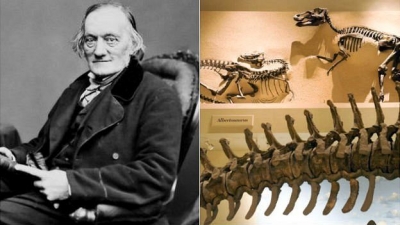
|
Around 1819, scientists identified some fossils as belonging to ‘giants’ they named Megalosaurus. In 1842 British scientist Richard Owen studied these fossils and noticed similarities among them and that they looked reptilian. He also realised that they were very different from any creatures that roamed Earth today. Owen coined the name ‘dinosaurs’, meaning ‘terrible lizards’. |
In 1842, the trailblazing British scientist Richard Owen announced the discovery of the dinosaurs to great acclaim. He described them as immense animals with thick limb bones and strong, reinforced hips. They were the “most perfect modifications of the Reptilian type”, and “must have played the most conspicuous parts, in their respective characters as devourers of animals and feeders upon vegetables, that this world has ever witnessed in oviparous and cold-blooded creatures”.
Two decades earlier, scientists already knew of the existence of gigantic sea reptiles in the distant past, but by the time of Owen’s publication, clues were emerging that equally impressive reptiles had lived on land as well. The first of these “dinosaurs-to-be” was a huge carnivore, discovered in an English rock known as the Stonesfield Slate, and published by William Buckland in 1824 under the name Megalosaurus. Buckland imagined it to be a fearsome predatory lizard with a total body length of 18–21 m (60–70 ft).
A second “dinosaur-to-be” was found by Gideon Mantell, a medical doctor and amateur fossil collector from the small market town of Lewes in East Sussex, in southern England. Mantell built up an impressive collection of fossils from his neighborhood over the years, first publishing on them in 1822. However, the fact that he lived outside the socio-political center of 19th-century England counted against him, despite his best efforts to make his way in London scientific circles. By the early 1820s, Mantell had obtained several unusual fossil teeth that came from the Tilgate Grit (now known to be Lower Cretaceous in age), and in 1825 he named Iguanodon for these remains. Since the teeth resembled those of iguanas, he regarded Iguanodon as lizard-like but enormous in size, its length perhaps exceeding 30 m (100 ft).
third “dinosaur-to-be” was, like Iguanodon, also from the county of East Sussex. The specimen was uncovered by workmen and blasted into fragments that Mantell later managed to fit together, and in 1833 he named it Hylaeosaurus. It is a big armored reptile with large conical spines arranged on the neck and shoulders, and has remained poorly known. Certainly it has never become as familiar to the public as Megalosaurus or Iguanodon.
Credit: Scientific American
Picture Credit : Google




